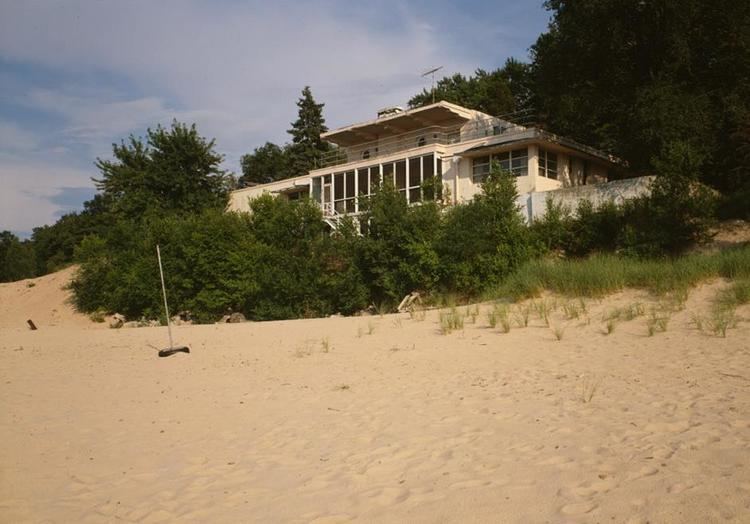Architect Walter Scholer, et al. Year built 1933 | NRHP Reference # 86001472 Added to NRHP 30 June 1986 | |
 | ||
Location 208, 210, 212, 214, and 215 Lake Front Dr., Beverly Shores, Indiana | ||
The Century of Progress Architectural District, a part of the eastern unit of Indiana Dunes National Lakeshore, is an historic district on Lake Front Drive in Beverly Shores, Porter County, Indiana. The district comprises five buildings, all from the Homes of Tomorrow Exhibition during the 1933 Century of Progress World's Fair which took place in Chicago. Intended to display the future of housing, the Century of Progress Homes reflect a variety of designs, experimental materials and new technologies. On June 30, 1986, the district was listed on the National Register of Historic Places as the Beverly Shores—Century of Progress Architectural District.
Contents
Century of Progress
The Beverly Shores/Century of Progress Architectural District is significant because it encompasses houses from the 1933–34 Chicago Century of Progress Exposition that comprised a portion of the Home and Industrial Arts Group. These structures were innovative and included engineering and construction technologies that are integral parts of modern residential architecture.
During the 1893 Columbian Exposition, the classicism of the French Beaux Arts tradition was popular along with the eclectic revivals of the Victorian architectural periods. This trend dominated American architecture during the first part of the twentieth century. Forty years later, Chicago's Century of Progress Exposition was the national showcase for new directions in American architecture, which once again followed a European precedent, the 1925 Paris Exposition." The Century of Progress Exposition was conceived in the prosperous 1920s, but the nation was deep in the Great' Depression by the opening date. Modern technology, the general theme of the exposition, gave the nation something new during a bleak economic period. New materials, nontraditional construction methods, and efficient, new mechanical systems came together." Electric floodlights, searchlights and neon highlighted the polychromed facades and stylized motifs of the major exhibition buildings. The architecture of the Century of Progress Expostion was progressive, which meant either the Art Deco or International Style.."
Move to Beverly Shores, Indiana
After the closing of the 1933 World's Fair, in late winter 1935 the Century of Progress houses were moved from Chicago to Indiana. Robert Bartlett purchased the homes with the intent of using them to sell more properties in his new residential development called Beverly Shores. Owing to their lakefront location in Chicago and their future lakefront location in Indiana, it was determined the easiest way to transport the homes was by barge. The houses were rolled off the barge on telephone poles onto a heavy timber crib built out into the lake. There were a series of three steps used to raise the house to the level of Lake Front Drive.
Contributing properties
The five contributing properties in the architectural district are:
Significance
The Beverly Shores Century of Progress Architectural District encompasses houses from the 1933–34 Chicago Century of Progress Exposition that comprised a "portion of an exhibit known as the Home and Industrial Arts Group. Many of these structures were innovative and displayed engineering and construction technologies that have become an integral part of modern residential architecture."
In hosting the 1893 Columbian Exposition, Chicago made the classicism of the French Beaux Arts tradition popular with an American public coming from the Victorian architectural periods. This trend dominated American architecture during the first part of the twentieth century. Forty years later, Chicago's Century of Progress Exposition was the national showcase for new directions in American architecture, which again followed a European precedent, the 1925 Paris Exposition.
Current status
The houses have been restored and all are open one day a year for public tours, the most recent one being on Saturday, October 22, 2011.
